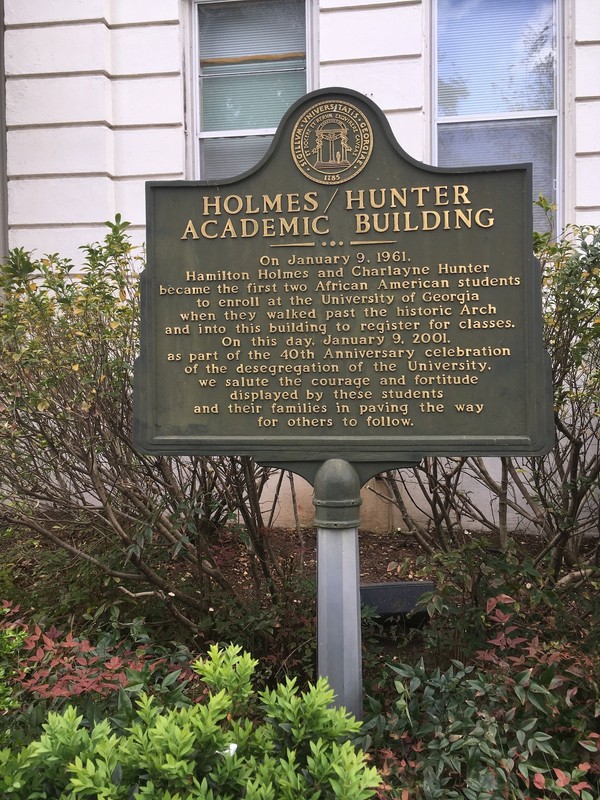Hunter-Holmes Academic Building
Introduction
Text-to-speech Audio
Hunter-Holmes academic building
The Hunter Holmes academic building is named after Charlayne Hunter-Gault, and Hamilton Holmes. Hunter and Holmes were the first two African American students to enroll in the University of Georgia. The building is located next to the arch and serves multiple purposes for UGA students, faculty and staff.
The Hunter Holmes academic building or as it was formerly known as the academic building, was originally two seperate buildings. One of the buildings housed some administrative offices and classrooms, this building was known as Ivy building. The other building was the University library. In the year 1903 it was proposed that these two buildings be joined together with stairs and columnns. The reason for the proposed consolidation was because the University was growing, and more classrooms were needed. The University had also just received $50,000 from George Foster Peabody for a new library which would leave the old library vacant.
The person in charge of the consolidation of the two buildings was Charles M. Strahan who was the head of the engineering department at the University of Georgia. Strahan altered the exterior of the Ivy building in order for it to match the exterior of the library. Strahan also added an extra floor to the Ivy building which made it match the height of the old library building. Strahan stuck to the proposal and combined the buildings through stairs and columnns. Strahan also added a Corinthian portico which supports an exposed stairway that gives access to the upper floors. The project was completed in 1906.
The academic building has a special place in alumni’s experience at the University of Georgia. An example of such an alumni is William Tate who was a Dean of the University of Georgia from 1946 to 1971. As a student William Tate had all of his Freshman year classes, and most of his sophomore year classes in the building. The following year he would have four out of six classes in the building. During his tenure as dean at the University of Georgia, his office was in the academic building. In a 1964 article of the Red and Black newspaper one observer pointed out, “As the University grew so did the Academic Building, but it never outgrew Dean Tate”.
The building was renamed to Hunter-Holmes academic building on January 9th 2001 marking 40 years of desegregation at the University of Georgia. The academic building was the building in which both Hunter and Holmes registered for classes in 1961 at the University of Georgia. Many prominent people attended the ceremony including the Governor Roy Barnes, the mayor of Athens Doc Eldridge and the University president Michael Adams. Unfortunately, Holmes did not attend the ceremony as he had passed away six years earlier. During the ceremony Charlayne Hunter-Gault said, “I have always felt that the bond between (Hamilton) and me was as thick as blood. Now, it’s as thick as cement”.
During the ceremony a Georgia historical marker was put in front of the building. Although this building is supposed to serve as a sort of memorialization of Hunter and Holmes, one could argue that the marker presents the history as uncomplicated and does not mention the nuances of the integration of the University. The Marker mentions the fortitude displayed by the students, but it does not mention the fact that fortitude had be shown because UGA students protested the enrollment of Hunter and Holmes. In an almost poetic turn of events the Hunter Holmes academic building now holds the University's institute for African American studies. The building in which African Americans were not allowed in is now a place where they can now claim some sort of ownership.
Images




Sources
Georgiana Vertical Files, University of Georgia, UA12-029, University Archives, Hargrett Rare Book and Manuscript Library, The University of Georgia Libraries.
Graffus, Kerri. "Building renamed during desegregation ceremony." The Red And Black (Athens, GA), Jan 10, 2001.
Graffus, Kerri. "Building renamed during desegregation ceremony." The Red And Black (Athens, GA), Jan 10, 2001.
